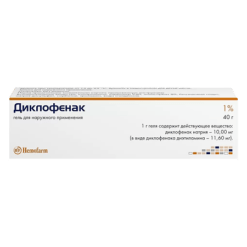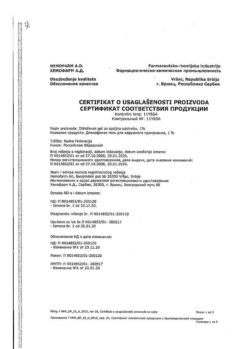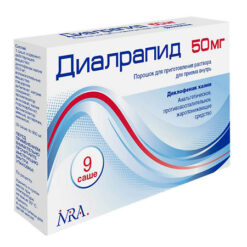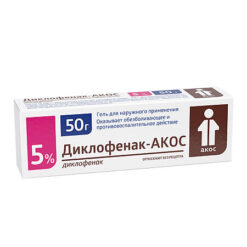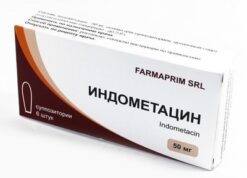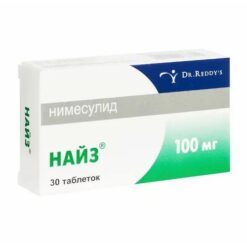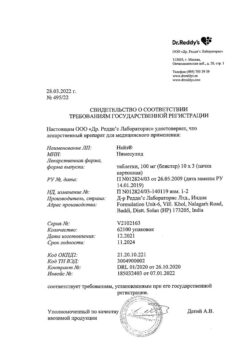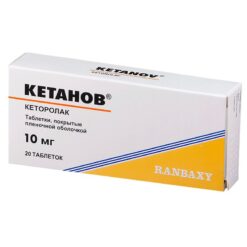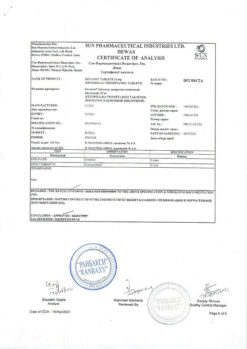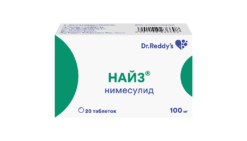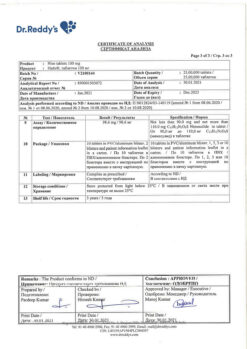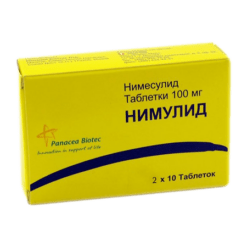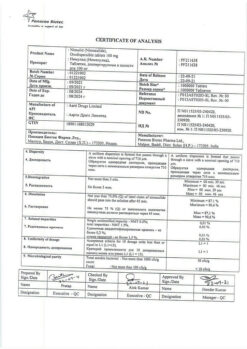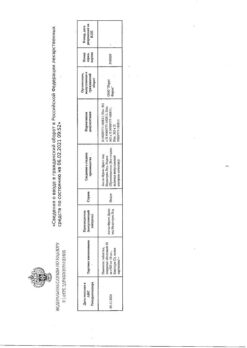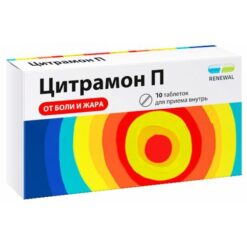No products in the cart.
Diclofenac, rectal, 100 mg 10 pcs
€3.88 €3.53
Description
Pharmgroup:
NSAIDs.
Pharm Action:
Penylacetic acid derivative NSAID; has anti-inflammatory, analgesic and antipyretic effects. By indiscriminate inhibiting COX1 and COX2, it disrupts arachidonic acid metabolism, decreases amount of Pg in inflamed area.
It is most effective for pain of inflammatory nature. Like all NSAIDs, the drug has antiaggregant activity.
Pharmacokinetics:
Absorption is fast and complete, food slows the rate of absorption. After oral administration of 50 mg, Cmax is 1.5 mcg/ml, TCmax is 2-3 h.
Diclofenac prolonged action: as a result of delayed drug release, the Cmax in plasma is lower than that of short-acting drugs; however, it remains high for a long time after administration. Cmax is 0.5-1 mcg/ml, TCmax is 5 h after administration of 100 mg long-acting tablets.
After an IV infusion of 75 mg, Cmax is 1.9 µg/mL (5.9 µmol/L). After intravenous administration, Cmax is 2.5 µg/mL (8 µmol/L), TCmax is 20 min.
In rectal administration TCmax – 30 min.
The plasma concentration is in a linear relationship to the amount of dose administered.
There is no change in the pharmacokinetics of diclofenac on repeated administration. It does not cumulate if the recommended interval between meals is observed.
The bioavailability is 50%. Binding with plasma proteins is more than 99% (most of it is bound with albumin). Transfers to breast milk and synovial fluid; Cmax in synovial fluid is observed 2-4 hours later than in plasma. T1/2 from synovial fluid is 3-6 h (the drug concentrations in synovial fluid are higher 4-6 h after administration than in plasma and remain higher during 12 h).
50% of the drug is metabolized during the “first passage” through the liver; AUC is half as much after oral administration than after parenteral administration of the same dose. Metabolism occurs as a result of multiple or single hydroxylation and conjugation to glucuronic acid. The CYP2C9 isoenzyme is also involved in the metabolism of the drug. The pharmacological activity of the metabolites is less than that of diclofenac.
The systemic clearance is 260 ml/min. T1/2 from plasma is 1-2 hours. 60% of the administered dose is excreted as metabolites through the kidneys; less than 1% is excreted unchanged, the rest of the dose is excreted as metabolites in the bile.
In patients with significant renal insufficiency (CKD less than 10 ml/min) excretion of metabolites in bile is increased, while there is no increase of their concentrations in blood.
In patients with chronic hepatitis or compensated liver cirrhosis pharmacokinetic parameters do not change.
Indications
Indications
Inflammatory and inflammation-activated degenerative forms of rheumatism:
chronic polyarthritis;
ankylosing spondylitis (ankylosing spondylitis);
arthrosis;
spondyloarthrosis;
neuritis and neuralgia, such as cervical syndrome, lumbago (lumbago), sciatica;
acute attacks of gout.
Rheumatic lesions of soft tissues.
Painful swelling or inflammation after injury or surgery.
Non-rheumatic inflammatory pain conditions.
Pharmacological effect
Pharmacological effect
Pharmaceutical group:
NSAIDs.
Pharmaceutical action:
NSAID, phenylacetic acid derivative; has anti-inflammatory, analgesic and antipyretic effects. By indiscriminately inhibiting COX1 and COX2, it disrupts the metabolism of arachidonic acid and reduces the amount of Pg at the site of inflammation.
Most effective for inflammatory pain. Like all NSAIDs, the drug has antiplatelet activity.
Pharmacokinetics:
Absorption is rapid and complete; food slows down the rate of absorption. After oral administration of 50 mg, Cmax is 1.5 mcg/ml, TCmax is 2-3 hours.
Long-acting diclofenac: as a result of the delayed release of the drug, Cmax in plasma is lower than that created by the administration of short-acting drugs; however, it remains high for a long time after administration. Cmax – 0.5-1 mcg/ml, TCmax – 5 hours after taking 100 mg extended-release tablets.
After intravenous drip administration of 75 mg, Cmax is 1.9 μg/ml (5.9 μmol/l). After intramuscular administration, Cmax is 2.5 mcg/ml (8 μmol/l), TCmax is 20 minutes.
For rectal administration, TCmax is 30 minutes.
Plasma concentration is linearly dependent on the administered dose.
There are no changes in the pharmacokinetics of diclofenac following repeated administration. Does not accumulate if the recommended interval between meals is observed.
Bioavailability – 50%. Communication with plasma proteins is more than 99% (most of it is associated with albumin). Penetrates into breast milk and synovial fluid; Cmax in synovial fluid is observed 2-4 hours later than in plasma. T1/2 from synovial fluid – 3-6 hours (concentrations of the drug in synovial fluid 4-6 hours after its administration are higher than in plasma, and remain higher for another 12 hours).
50% of the drug is metabolized during the “first pass” through the liver; AUC is 2 times less after oral administration of the drug than after parenteral administration of the same dose. Metabolism occurs as a result of multiple or single hydroxylation and conjugation with glucuronic acid. The CYP2C9 isoenzyme is also involved in the metabolism of the drug. The pharmacological activity of the metabolites is less than that of diclofenac.
Systemic clearance is 260 ml/min. T1/2 from plasma – 1-2 hours. 60% of the administered dose is excreted in the form of metabolites through the kidneys; less than 1% is excreted unchanged, the rest of the dose is excreted as metabolites in the bile.
In patients with severe renal failure (creatinine clearance less than 10 ml/min), the excretion of metabolites in bile increases, but no increase in their concentration in the blood is observed.
In patients with chronic hepatitis or compensated liver cirrhosis, pharmacokinetic parameters do not change.
Active ingredient
Active ingredient
Diclofenac
Composition
Composition
Active ingredient:
diclofenac 100 mg;
Excipients:
1,2-propylene glycol,
aerosil,
vitepsol
Contraindications
Contraindications
Hypersensitivity (including to other NSAIDs), complete or incomplete combination of bronchial asthma, recurrent polyposis of the nose and paranasal sinuses and intolerance to ASA or other NSAIDs (including a history), erosive and ulcerative lesions of the gastrointestinal tract and duodenum, active gastrointestinal bleeding, inflammatory bowel diseases, severe liver and heart failure; period after coronary artery bypass surgery; severe renal failure (creatinine clearance less than 30 ml/min), progressive kidney disease, active liver disease, confirmed hyperkalemia, pregnancy (III trimester), lactation period, children’s age (up to 14 years – for enteric-coated tablets 50 mg and rectal suppositories 50 mg, up to 18 years – for extended-release tablets and suppositories 100 mg).
For rectal use (additionally): proctitis.
For dosage forms containing lactose (additionally): hereditary lactose intolerance, impaired absorption of glucose-galactose, lactase deficiency.
With caution. Peptic ulcer of the stomach and duodenum, ulcerative colitis, Crohn’s disease, history of liver disease, hepatic porphyria, chronic renal failure, heart failure, arterial hypertension, significant decrease in blood volume (including after extensive surgery),
elderly patients (including those receiving diuretics, debilitated patients and those with low body weight), bronchial asthma, concomitant use of corticosteroids (including prednisolone), anticoagulants (including warfarin), antiplatelet agents (including ASA, clopidogrel), selective serotonin reuptake inhibitors (including citalopram, fluoxetine, paroxetine, sertraline), ischemic heart disease, cerebrovascular diseases, dyslipidemia/hyperlipidemia, diabetes mellitus, peripheral arterial disease, smoking, chronic renal failure (creatinine clearance 30-60 ml/min), presence of Helicobacter pylori infection, long-term use of NSAIDs, alcoholism, severe somatic diseases.
Side Effects
Side Effects
From the digestive system: nausea, vomiting, epigastric pain, anorexia, flatulence, constipation, gastritis up to erosive with bleeding, increased transaminase activity, drug-induced hepatitis, pancreatitis.
From the urinary system: interstitial nephritis.
From the side of the central nervous system: headache, dizziness, disorientation, agitation, insomnia, irritability, fatigue, aseptic meningitis.
From the respiratory system: bronchospasm.
From the hematopoietic system: anemia, thrombocytopenia, leukopenia, agranulocytosis.
Dermatological reactions: exanthema, erythema, eczema, hyperemia, erythroderma, photosensitivity.
Allergic reactions: erythema multiforme, Lyell’s syndrome, Stevens-Johnson syndrome, anaphylactic reactions, including shock.
Local reactions: burning, formation of infiltrate, and necrosis of adipose tissue are possible at the injection site.
Other: fluid retention in the body, edema, increased blood pressure.
Interaction
Interaction
With the simultaneous use of Diclofenac with digoxin, phenytoin or lithium preparations, it is possible to increase the plasma concentrations of these drugs; with diuretics and antihypertensive drugs – the effect of these drugs may be reduced; with potassium-sparing diuretics – hyperkalemia may develop; with acetisalicylic acid – a decrease in the concentration of diclofenac in the blood plasma and an increased risk of side effects.
Diclofenac may enhance the toxic effect of cyclosporine on the kidneys.
Diclofenc can cause hypo- or hyperglycemia, therefore, when used simultaneously with hypoglycemic agents, monitoring of blood glucose concentrations is required.
When using methotrexate within 24 hours before or after taking Diclofenac, the concentration of methotrexate may increase and its toxic effect may increase.
When used simultaneously with anticoagulants, regular monitoring of blood clotting parameters is necessary.
Storage conditions
Storage conditions
Store in a dry place, protected from light at a temperature not exceeding 25 C.
Manufacturer
Manufacturer
Dalkhimfarm, Russia
Additional information
| Conditions of storage | Store in a dry, light-protected place at a temperature not exceeding 25 C. |
|---|---|
| Manufacturer | Dalkhimpharm, Russia |
| Medication form | rectal suppositories |
| Brand | Dalkhimpharm |
Other forms…
Related products
Buy Diclofenac, rectal, 100 mg 10 pcs with delivery to USA, UK, Europe and over 120 other countries.



